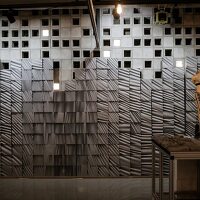
When we say ‘renovation’ or ‘remodeling,’ of architecture, we often think of repairing a run-down building that has lost its function over time. These days, however, it is easy to see unfinished structures that have been suspended mid-construction due to profitability issues. These are projects in which a person bought some land for the purpose of speculative investment in real estate and without carefully reviewing profitability, got a construction permit and started to build.

Unlike urban regeneration, which reconstructs and heals the city by utilizing the surrounding environment that already exists, how should this abandoned structure, of which its architectural purpose is unclear from the start, and which has no story planted in the ground, be regenerated within the city?

The site where this half-built structure sits, Munho-ri, Seojong-myeon, Yangpyeong-gun, was a piece of land in Yangpyeong, which was on the rise as a tourist destination near the metropolitan area. After purchasing the land for the purpose of real estate speculation and starting construction, it was never completed. Though it has stood as a cold concrete frame for a long time, we hope that it will be permeated by warmth, as people inhabit it. If a space is functionally fixed, the place is likely to vanish when there is no more use for it.

True architectural regeneration should transcend simple rehabilitation, and become an urban renewal capable of self-sprouting that can continue to create new stories by communicating with each other in the city, regardless of what program it holds. In order to do that, architecture needs to play the role of putting together and weaving various aspects of daily life on the earth, consuming and sharing the everyday stories hidden in that place. Architecture that possesses the new format that is desired by the place starts with rediscovering the place that has been put off in the many stories faced by the area.

문호리 셀프 스프라우팅
우리는 건축의‘ 레노베이션’ 또는‘ 리모델링’이라고 하면, 시간이 지나면서 그 기능을 잃고 낙후된 건물의 개보수와 수선을 흔히 떠올린다. 하지만 요즘엔 부동산 투기의 목적으로 땅을 구입하여 수익성의 면밀한 검토 없이 무작정 건축허가를 받아놓고 건물을 짓기 시작하다가, 공사 중에 사업성의 문제로 중단되어 골조 상태에서 멈춘 미완성의 구조물을 흔히 보게 된다. 과거로부터 존치되어있던 주변의 환경을 활용하여 도시를 재구축하고 치유하는 도심재생과는 달리, 애초부터 건축적 목적이 불분명하고, 과거로부터 땅에 심겨진 이야기가 부재하여 버림 당한 이 구조물은 어떻게 도심 속에서 재생되어야 하는 것일까?

양평군 서종면 문호리에 위치한 이 반-구조물은, 양평이 수도권 내 가까운 여행지로 부상하던 시기에 부동산 투기를 위해 땅을 산 후, 건물을 짓다가 완성을 보지 못하고 손 놓아 버린 땅이었다. 오랜 동안 차갑게 서있던 콘크리트 골조였지만, 이젠 사람들이 거주하면서 따뜻한 온기가 베이길 기대한다. 기능적으로 고정적인 공간은 그 쓰임이 끝났을 때 장소까지도 소멸해버리기 쉽다.

진정한 건축재생이란 단순한 재활의 의미를 넘어서 어떠한 프로그램을 담아도 도심 속에서 서로 소통하면서 새로운 스토리를 계속해서 생성시킬 수 있는 자기발아(Self-Sprouting)가 가능한 도시적 재생이어야 할 것이다. 그러기 위해서 건축은 그 장소에 숨어있는 일상의 이야기를 소비하고 공유하면서 대지 위에서 다양한 일상의 단면들을 담아내고 엮어내는 역할이 필요하다. 그 장소가 원하는 새로운 형식을 갖춘 건축은 지역이당면한 수많은 이야기 안에서 그동안 미뤄두었던 장소의 재발견에서부터 시작한다.





Architect L'EAU Design
Location Yangpyeong-gun, Gyeonggi-do, Republic of Korea
Use Accommodation
Site area 1,280㎡
Built area 511.4㎡
Total floor area 657.4㎡
Building scope 3F
Structure Reinforced concrete
Exterior finish Clay brick, old blue brick, polycarbonate, EX-Metal, AL. Sheet
Photographer Kim Yongkwan
해당 프로젝트는 건축문화 2018년 4월호(Vol. 443)에 게재 되었습니다.
The project was published in the April, 2018 issue of the magazine (Vol. 443)
'Architecture Project > Other' 카테고리의 다른 글
| Road station Nabura Tosa saga (0) | 2018.06.15 |
|---|---|
| Restroom in the Mountains (0) | 2018.06.11 |
| Urban Folly-1,2 (0) | 2018.05.25 |
| An Installation at Seoul Biennale 2017 (0) | 2018.02.08 |
| Architecture-Led Production for a Private Event (0) | 2017.12.29 |
마실와이드 | 등록번호 : 서울, 아03630 | 등록일자 : 2015년 03월 11일 | 마실와이드 | 발행ㆍ편집인 : 김명규 | 청소년보호책임자 : 최지희 | 발행소 : 서울시 마포구 월드컵로8길 45-8 1층 | 발행일자 : 매일







